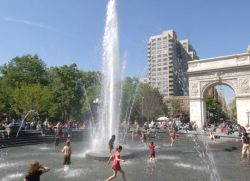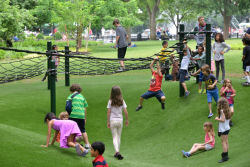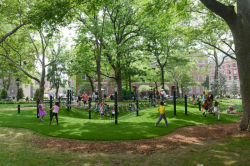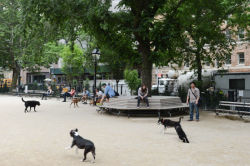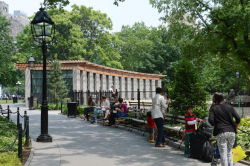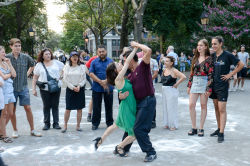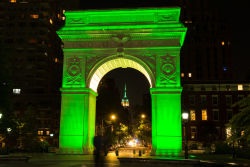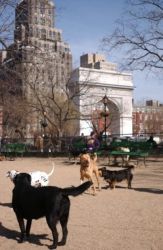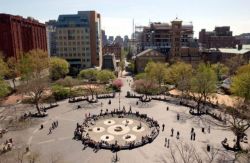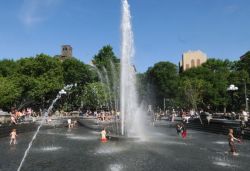Washington Square Park
The Daily Plant : Tuesday, January 23, 2007
The Free And Independent Republic Of Washington Square (Part I)
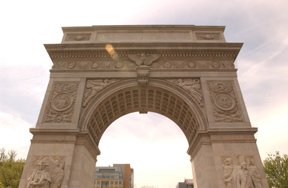
Photo by Spencer T Tucker
At the turn of the 20th century, a generation or two after flourishing as New York’s first genteel residential district, the neighborhood around Washington Square Park had become the center of the artistic and bohemian city. In the 1830s, as recounted in the Henry James novel Washington Square, rows of Greek Revival brick townhouses had become synonymous with elegance and social standing in the growing city. But by the time the neo-classical Washington Arch was erected at the foot of Fifth Avenue in 1895, the large single family homes were being broken up into smaller dwellings and studios, and a new urban form – the apartment building – was also being developed in the neighborhood.
In the first dozen years of the 20th century many artists and other creative types gravitated to Washington Square. In contrast to the artistic establishment exemplified by such uptown institutions as the Metropolitan Museum of Art and the National Academy of Arts and Letters, most of the downtown artists were considered more avant-garde, even subversive. A hint of the tension between artistic camps was revealed in this 1908 broadside from the National Academy, urging “those who have loved the literature and painting that are accepted by the winnowing hand of time to turn away from the Falsehoods of this period and again to embrace only the genuine expressions of man’s genius.”
The target of the artistic establishment was a group of upstart artists; many trained as artist-reporters for newspapers, mostly proteges of the realist painter Robert Henri. Henri and his followers settled in and around Washington Square in the early 1900s and began drawing and painting all manner of urban scenes – ranging from children playing in the square to more prosaic subjects such as laundry hanging in tenement backyards, longshoremen unloading ships, and streetcars picking up passengers. In addition to Henri, the bohemian artists included John Sloan, William Glackens, Everett Shinn, and George Luks. Their enthusiasm for painting and documenting the ordinary doings of the city earned them the derogatory name of the “Ashcan School of Painting,” embraced by the new painters as a badge of honor. Many of their realist drawings and prints were used as illustrations in contemporary publications such as the radical socialist journal, The Masses, which was published in the Greenwich Village area at this time.
Incensed by the exclusion of many realist painters from 1907’s National Academy spring show, Henri and his fellow artists mounted an alternative exhibition at a gallery on Fifth Avenue in February 1908. Dubbed by an editorial in the New York Evening Sun as “The Eight” – Henri, Sloan, Glackens, Shinn, and Luks had been joined by fellow artists Arthur Davies, Ernest Lawson, and Maurice Prendergast – the show of realist art was a huge success and marked the second “subversive” art event of 1908. That same year, photographer Alfred Stieglitz sponsored another seminal show at his gallery located at 291 Fifth Avenue. Studio 291 became noted as one of the era’s most significant art salons, along with those sponsored by art collectors Louise and Walter Arensberg and Mabel Dodge. Dodge’s salon, in particular, located at 23 Fifth Avenue just north of Washington Square, served as a meeting place for a wide range of writers and artists of all philosophical persuasions. Writers like John Reed, Max Eastman, Eugene O’Neill, and Lincoln Steffens conversed (and drank) at these salons with painters such as Henri, Sloan and Marcel Duchamp, cross-pollinating ideas and views.
One result of art salon ferment was the Association of American Painters and Sculptors, and the subsequent art show staged by the new group at the 69th Regiment Armory at East 25th Street and Lexington Avenue in February and March 1913. This controversial “Armory Show,” which served to introduce Americans in a big way both to artistic realism and to the emerging European modern art, is considered the most significant art event ever held in America, having in the words of one historian, “an immeasurable impact on the American public.”
But perhaps as significant a break with the artistic past as the 1913 Armory Show was an event that occurred 90 years ago today in Washington Square Park.
To be continued...
Written by Erik Peter Axelson
QUOTATION FOR THE DAY
“Laws are like sausages. It’s better not to see them being made.”
Otto von Bismarck
(1815 – 1898)
Check out your park's Vital Signs
Clean & Safe
Green & Resilient
Empowered & Engaged Users
Share your feedback or learn more about how this park is part of a
Vital Park System

